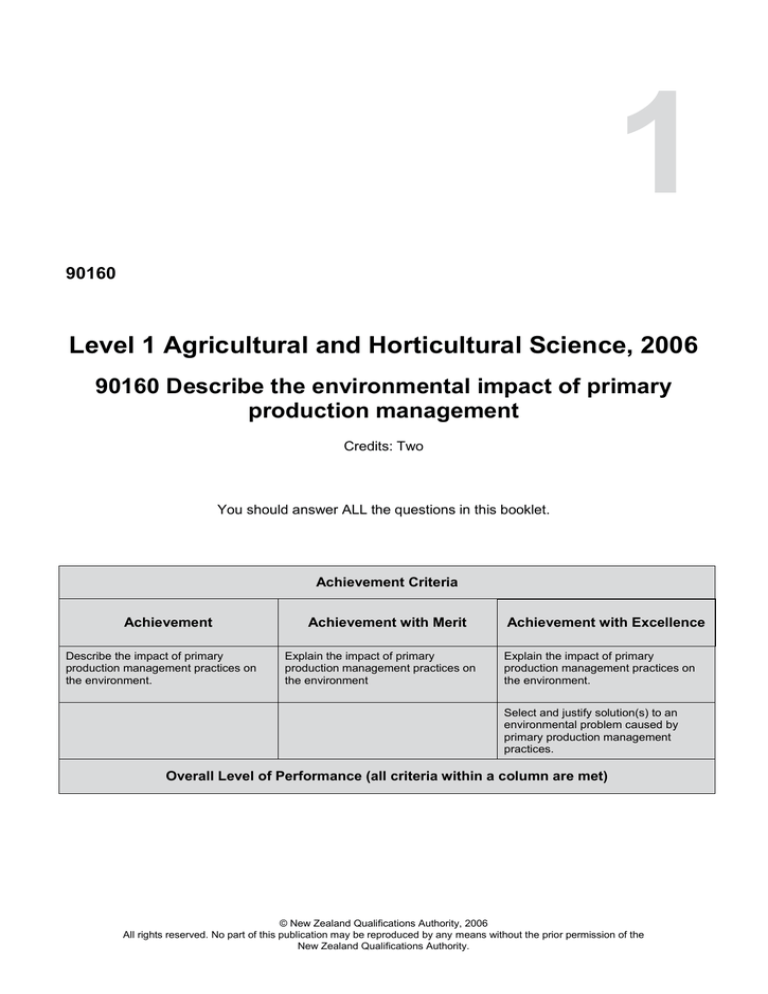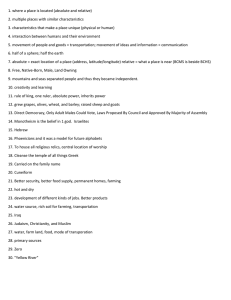
1
90160
Level 1 Agricultural and Horticultural Science, 2006
90160 Describe the environmental impact of primary
production management
Credits: Two
You should answer ALL the questions in this booklet.
Achievement Criteria
Achievement
Describe the impact of primary
production management practices on
the environment.
Achievement with Merit
Explain the impact of primary
production management practices on
the environment
Achievement with Excellence
Explain the impact of primary
production management practices on
the environment.
Select and justify solution(s) to an
environmental problem caused by
primary production management
practices.
Overall Level of Performance (all criteria within a column are met)
© New Zealand Qualifications Authority, 2006
All rights reserved. No part of this publication may be reproduced by any means without the prior permission of the
New Zealand Qualifications Authority.
You are advised to spend 25 minutes answering the questions in this booklet.
RESOURCE ONE: ‘Environmentally unfriendly’ farming practices
L1 Agricultural and Horticultural Science 2006, 90160 – page 2 of 6
QUESTION ONE
The cartoon drawings in Resource One show farming practices that are bad for the environment.
Choose any THREE of the drawings and describe the impact of the farming practice on the
environment. Explain why the practice is bad for the environment.
(a) Drawing (circle ONE):
(i)
A
B
C
D
E
What is the environmental impact of the farming practice?
(ii) Why this practice is bad for the environment:
(b) Drawing (circle ONE):
(i)
A
B
C
D
E
What is the environmental impact of the farming practice?
(ii) Why this practice is bad for the environment:
(c) Drawing (circle ONE):
A
B
C
D
E
(i)
What is the environmental impact of the farming practice?
(ii)
Why this practice is bad for the environment:
L1 Agricultural and Horticultural Science 2006, 90160 – page 3 of 6
QUESTION TWO
Choose any THREE of the drawings in Resource One, and describe how the farming practice shown
should be changed so that the impact on the environment is reduced. Explain why this would be
better for the environment.
(a) Drawing (circle ONE):
(i)
A
B
C
D
E
How farming practice should be changed:
(ii) Why this practice is better for the environment:
(b) Drawing (circle ONE):
(i)
A
B
C
D
E
How farming practice should be changed:
(ii) Why this practice is better for the environment:
(c) Drawing (circle ONE):
A
B
C
D
E
(i)
How farming practice should be changed:
(ii)
Why this practice is better for the environment:
L1 Agricultural and Horticultural Science 2006, 90160 – page 4 of 6
QUESTION THREE
RESOURCE TWO
Sexy way to kill bugs
Scientists are making ‘sex traps’ to kill mealy bugs which damage grape vines. The mealy
bug spreads the leaf-roller virus. The sex trap will use sex hormones, which are released by
the female, to lure males into a sticky trap.
Source (adapted): The Dominion Post, 29 July 2005
Irish wasp to fight evil weevil
A tiny wasp from Ireland is to be used by scientists to fight the clover root weevil. The
weevil costs an estimated $150 million in lost production each year. The adult weevil chews
clover leaves, while the larva attacks the clover roots and root nodules. The wasp will kill the
weevil by injecting it with an egg which hatches and eats the weevil from the inside out.
Source (adapted): The Dominion Post, 11 November 2005
The articles above give two examples of ways that scientists are trying to prevent pests and
diseases from harming New Zealand’s primary industries.
(a)
What would have been done in the past to control the mealy bug and clover root weevil?
(b)
Why are the techniques that scientists are starting to use now to control the mealy bug and
clover root weevil better for the environment?
L1 Agricultural and Horticultural Science 2006, 90160 – page 5 of 6
QUESTION FOUR
Each year fruit growers run the risk of having their crops damaged by frosts. Listed below are several
methods used by growers to combat frost, each of which has positive and negative effects on the
environment:
diesel burners
sprinklers
wind machines
cloth covers
planting on hillsides.
Select ONE method that would most effectively prevent frosts while having the lowest negative
environmental impact, and justify why your selection is better than each of the other methods.
Selected method:
Justification:
L1 Agricultural and Horticultural Science 2006, 90160 – page 6 of 6




